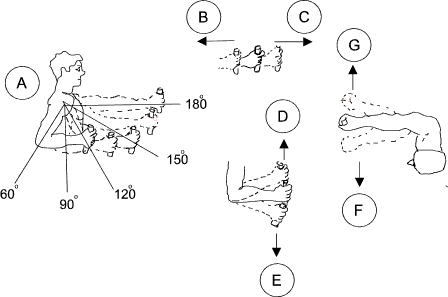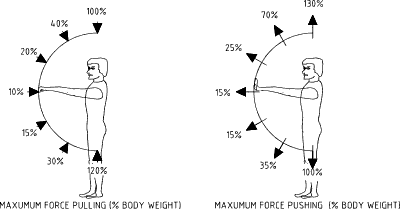Strength Categories
There are three basic categories of strength:
- Static strength(isometric strength),
which is steady force exerted while the limbs are in a
stationary or static position.
- Dynamic strength, which
is a force exerted by limbs moving in a smooth manner
over time, such as while lifting an object
- Explosive strength (impulsive strength), is the application of peak
amounts of strength for short periods of time, usually
periodically, such as in running or sprinting.
|
Obviously a person can exert the maximum forces with impulsive strength and the
minimum forces with static strength.
The strength of males increases steadily until approx 30yr. old.
This increase is most rapid beween the ages of 12 and 19. Similarly womens strength peaks at 30.
However the strength of women increases more uniformly between the ages of 9 and 19yrs
Women are approx. 35% to 85% as strong as men depending upon the muscles used
The left hand and arm are generaly 10% weaker than the right hand and arm
Strength means a momentary , single task maximum exertion, or a sustained effort.
Endurance refers to a sustained effort. Findings show that endurance is enhanced by exercise,
rest, food,and increased atmospheric pressure. However endurance is reduced by fatigue,
hunger, low atmospheric pressure, high temperature accompanied by high humidity and tobacco.
Muscular power is also reduced by excitement and mental work. Males have greater endurance than females >
Recovery Rate after a standard excercise has been found to be 40% after 1 mins rest, 65% after 2 mins rest, 85% after
4 mins rest and 96% after 8 mins rest
Selected Strength Values
Below are presented some strength values..
These must be used with extreme caution and are provided as
easy look-up values to give the feel of the forces related to certain
tasks. They are not intended to be statistically justifiable.
The links below include quality information to be used for important work..
Gripping Strength persons..... age 31 - 50; gripping a test handle 50mm wide x 100mm long
| Sex | Mean (N) | S.D (N) | Range (N) |
| Male | 54.03 | 7.04 | 43,10 - 64.40 |
| Female | 31.42 | 4.99 | 21,50 - 37,30 |
Turning Circular Knob persons.. age 31 - 50; Smooth 40 dia x 20 Dp horizontal axis
| Sex | Mean (Nm) | S.D (Nm) | Range (Nm) |
| Male | 4,48 | 1,69 | 2,56 -6,08 |
| Female | 3,89 | 1,32 | 1,45 � 6,13 |
Twisting Lid.... persons age 31 - 50; knurled Lid 65mm dia
| Sex | Mean (Nm) | S.D (Nm) | Range (Nm) |
| Male | 7,94 | 1,67 | 5,29 - -11,5 |
| Female | 4,75 | 1,72 | 1,22 � 6,93 |
Pulling Horizontal Bar.... age 31 - 50; Horizontal bar 20mm dia x 300 Lng 1-handed
| Sex | Mean (Nm) | S.D (Nm) | Range (Nm) |
| Male | 477,3 | 213,75 | 408,48 - 647,03 |
| Female | 294,87 | 96,29 | 189,75 - 460,09 |
Pushing Horizontal Bar.... age 31 - 50; Horizontal bar 20mm dia x 300 Lng 1-handed
| Sex | Mean (Nm) | S.D (Nm) | Range (Nm) |
| Male | 457,22 | 99,37 | 290,65 - 543,61 |
| Female | 314,47 | 136,42 | 215,91 - 500,26 |
Pressing Pedal .... age 31 - 50; A pedal 400mm length and 30mm wide, placed inside a 55mm wide space to restrict the amount of the
foot that can be placed onto the pedal.
| Sex | Mean (Nm) | S.D (Nm) | Range (Nm) |
| Male | 329,183 | 129,99 | 173,00 - 579.70 |
| Female | 237,99 | 106,80 | 121,50 - 435,60 |
Arm Strength values. (From USA - Adjusted (reduced) values based on tests on young men 80% of (5th percentile group) - Better info in link 4 below
| A | B | C | D | E | F | G |
| | L(N) | R(N) | L(N) | R(N) | L(N) | R(N) | L(N) | R(N) | L(N) | R(N) | L(N) | R(N) |
| 180o | 177.6 | 184.8 | 149.6 | 177,6 | 32 | 49,6 | 46,6 | 60,8 | 46,6 | 71,2 | 28,8 | 49,6 |
| 150o | 149,6 | 199,2 | 106,4 | 149,6 | 53,6 | 64 | 64 | 71,2 | 53,6 | 71,2 | 28,8 | 53,6 |
| 120o | 120,8 | 149,6 | 92,8 | 128 | 60,8 | 85,6 | 74,4 | 92,8 | 71,2 | 78,4 | 36 | 53,6 |
| 90o | 113,6 | 132 | 78,4 | 128 | 60,8 | 71,2 | 74,4 | 92,8 | 56,8 | 64 | 36 | 56,8 |
| 60o | 92,8 | 85,6 | 78,4 | 120,8 | 53,6 | 71,2 | 60,8 | 71,2 | 42,4 | 60,8 | L | R |
Lifting Height
With ample work space of young fit men can lift these weights to the heights indicated.
180 N to a lifted height = 1.5m... 280 N. to a lifted height of 0.9m... 590 N to a lifted heigh of 0.6m...
680N to a lifted height of 0.3m.
Leg Strength
People use legs when standing, walking running and when cycling and operating foot
controls....The legs are generally capable of lifting and supporting high loads.
When standing with the legs locked the legs can support very high loads.
I've reviewed the various data sources and there is such a scatter of information that
anything I include at this basic level could be misleading..The links below provide quality
information on this topic
To give intuitive guidance a couple of values are provided below .
Pedal torque on a bicycle..
maximum torque on one pedal is the weight of the cyclist
x radius . For a 82 kg man. with a pedal radius of 160mm this results in a maximum torque
of 129 Nm.
Standing from a sitting position.
Knee joint at 90o.
A normal person (e.g. me weighing 13 stone) can just stand slowly using one leg therefore the leg
can exert a force of about 800N.
Standing Strength
|

